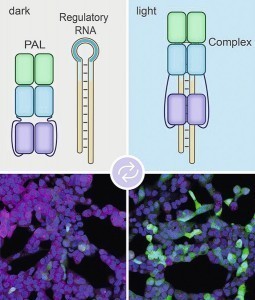A new type of optical switch makes it possible to precisely control the lifetime of genetic "transcripts". These serve the cell as building instructions for the production of proteins. The method was developed by scientists at the Universities of Bonn and Bayreuth. It could significantly advance the investigation of dynamic processes in living cells. The study has been published in the journal Nature Communications [1].
 When illuminated (right), the PAL molecule binds to the aptamer (blue loop top left). The label from regulatory RNA can therefore no longer bind to the mRNA. This prevents it from being degraded The genes in the nucleus of every human cell contain the instructions for building proteins. When the cell needs a certain protein, a copy of the corresponding instructions is made in the form of messenger RNA, the so-called mRNA (RNA is a slightly modified form of the genetic material DNA).
When illuminated (right), the PAL molecule binds to the aptamer (blue loop top left). The label from regulatory RNA can therefore no longer bind to the mRNA. This prevents it from being degraded The genes in the nucleus of every human cell contain the instructions for building proteins. When the cell needs a certain protein, a copy of the corresponding instructions is made in the form of messenger RNA, the so-called mRNA (RNA is a slightly modified form of the genetic material DNA).
A cellular mechanism ensures that the mRNA transcripts are "shredded" again after a short time. This ensures that the protein is only produced for as long as it is actually needed. A few decades ago, scientists came up with the idea of using this shredder for their own purposes: By specifically attaching a marker to certain mRNAs, they ensure that the transcripts do not serve as building instructions in the first place, but are destroyed directly - a process also known as RNA silencing. The cell then lacks the corresponding protein. This makes it possible to find out which function it would actually be responsible for.
The approach that the groups from Bonn and Bayreuth have now published is based on this method. It allows extremely differentiated control over the lifespan of the mRNA copies. By using a bacterial molecule, the shredding of the mRNA transcripts can be controlled with the help of light. The bacterial molecule with the abbreviation PAL acts as a kind of switch. Under the influence of blue light, it changes its shape into a form to which certain molecules can bind. From a huge library of artificially produced short RNA molecules, so-called aptamers, the researchers have identified an aptamer that matches the shape of the PAL molecule very well.
The researchers have now coupled this aptamer to one of the molecular markers that can attach to mRNAs and thus release them for degradation. When the cell is now irradiated with blue light, PAL binds to the marker via the aptamer and thus disables it. The mRNA is then not destroyed but translated into the corresponding protein. As soon as the blue light is switched off, PAL releases the marker again. Now it can attach itself to the mRNA, which is then shredded.
In this way, it is now possible to investigate exactly where and when a protein is needed in a cell - simply by immersing an area of the cell in blue light at a specific time and then looking at the consequences. In the current study, the method was tested for proteins that play an important role in the regulation of the cell cycle and cell division. The combination of aptamer and degradation marker is introduced into the cell by genetic engineering. The cell then generates the light-dependent degradation signal itself and does not need to be supplied from outside.
The aptamer can be combined with any marker, each of which in turn serves as a shredding signal for a specific mRNA. This method can therefore be used to switch off practically any mRNA molecule in the cell in a controlled manner. In the recently published pilot study, the whole thing worked both simply and reliably. The scientists therefore see great potential in their method for researching dynamic processes in living cells and organisms.
Source: University of Bonn, contact person: Prof. Dr. Günter Mayer


